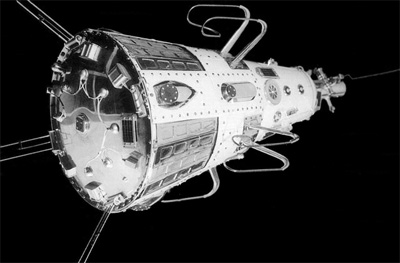Thank you very much for visiting Gunter's Space Page. I hope that this site is useful and informative for you.
If you appreciate the information provided on this site, please consider supporting my work by making a simple and secure donation via PayPal. Please help to run the website and keep everything free of charge. Thank you very much.
Sputnik 3 (D-1 #1, 2)

Sputnik-3
The D-1 satellite, better known as Sputnik 3 was the first complex scientific satellite.
Originally planned to be the first satellite to be launched, it suffered delays and instead the simpler PS-1 became, by the name of Sputnik 1, the first satellite to orbit earth.
The 1327 kg D-1 satellite consisted of a conical pressurized body and was powered by batteries for a lifetime of one month. It had no stabilisation systems. A tape recorder recorded the data and allowed playback of data from parts of the orbit beyond the range of ground stations. Scientific instruments included a magnetometer and field-mill electrometer to measure fields in space, four space radiation detectors to study cosmic and solar particle radiation, a mass spectrometer and two pressure gauges to analyze the rarified outer atmosphere, an ion trap to measure plasma, and a piezoelectric microphone to count micrometeorite strikes. Also on board was an experimental solar batterie to power one of the transmitters.
Following experiments were on board:
- Fluxgate Magnetometer
- Field Mill Electrometer
- Spherical Ion Traps
- Quadrupole Mass Spectrometer
- Ionization Manometer
- Magnetic Manometer
- Piezo-Electric Meteorite Counter
- Silicon Solar Battery
- Cherenkov Heavy-Nuclei Counter
- Zinc Sulfide Fluoroscopes
- Gas Discharge Counters
- Sodium Iodide Scintillation Counter
The first D-1 satellite was launched on 27th April 1958, but failed to reach orbit as the launch vehicle was destroyed by an excessive pogo-effect 88 seconds into the flight.
The second satellite was launched successfully on 15th May 1958 and received the name Sputnik 3. It operated for about one month.
| Nation: | USSR |
|---|---|
| Type / Application: | Scientific |
| Operator: | |
| Contractors: | |
| Equipment: | See above |
| Configuration: | |
| Propulsion: | None |
| Power: | Batteries, solar cells |
| Lifetime: | ~ 1 month |
| Mass: | 1327 kg |
| Orbit: | 217 km × 1864 km, 65.2° |
| Satellite | COSPAR | Date | LS | Launch Vehicle | Remarks | |
|---|---|---|---|---|---|---|
| Sputnik (3) (D-1 #1) | 1958-F03 | 27.04.1958 | Ba LC-1/5 | F | Sputnik (8A91) | |
| Sputnik 3 (D-1 #2) | 1958 δ 2 | 15.05.1958 | Ba LC-1/5 | Sputnik (8A91) |
References:
- Don P. Mitchell: Sputnik 3
